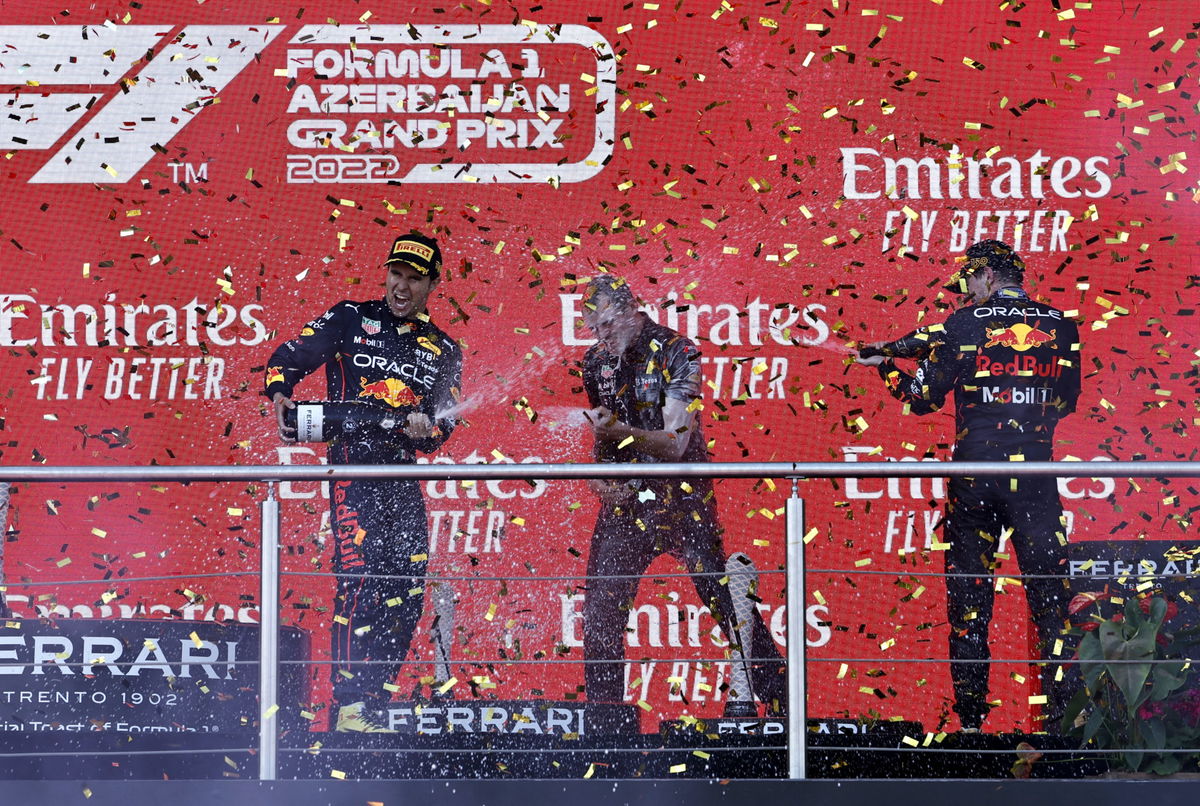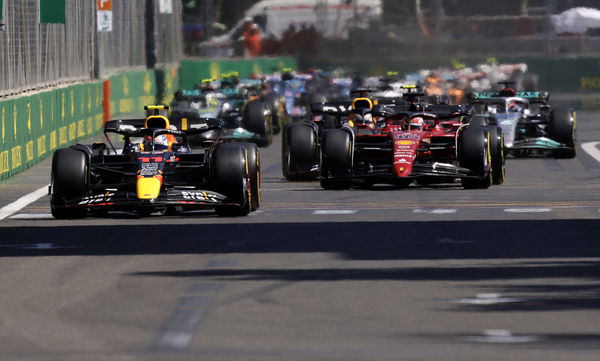
Reuters
Formula One F1 – Azerbaijan Grand Prix – Baku City Circuit, Baku, Azerbaijan – June 12, 2022 Red Bull’s Max Verstappen celebrates on the podium after winning the race alongside second place Red Bull’s Sergio Perez REUTERS/Hamad I Mohammed

Reuters
Formula One F1 – Azerbaijan Grand Prix – Baku City Circuit, Baku, Azerbaijan – June 12, 2022 Red Bull’s Max Verstappen celebrates on the podium after winning the race alongside second place Red Bull’s Sergio Perez REUTERS/Hamad I Mohammed
Hosting a Formula 1 race is a prestigious and lucrative endeavor for cities and racetracks around the world. However, the privilege of hosting such an esteemed event comes at a significant cost. Race tracks are required to pay substantial fees to the authorities for the privilege of hosting a race, and these costs can vary greatly from as low as $15 million to as high as $55 million, depending on the location and nature of the circuit. The sport has developed so much that, starting with the championship organizers paying to use the tracks, things have taken a 180-degree turn.
Watch What’s Trending Now!
Today, we’re looking at the fees paid by the organizers of the Azerbaijan GP to host the race at the Baku City Circuit. After hosting the European GP for the first time in 2016, the race in the country was renamed the Azerbaijan GP in 2017. And surprisingly, the race has been filled with action to the brim on each outing. So, what is the cost that the organizers pay for the rights to stay on the calendar?
READ MORE: Has Any F1 Driver Been the King of Baku Streets at the Azerbaijan GP?
ADVERTISEMENT
Currently contracted until the 2024 season of Formula 1, the Azerbaijan GP’s organizers pay a whopping $55 million for the race’s permission, as reported by RacingNews365 in 2022. The fee in itself is right at the top among all the other venues and is tied with the Saudi Arabia GP, which made its debut in 2021. The contract for Azerbaijan was extended after the race in 2020 wasn’t held due to COVID-19. So with the rights coming to an end, the organizers are all set to secure a 10-year deal.
Azerbaijan claims a $500 million boost from hosting F1
The cost to keep the rights is massive. But it generally is on the higher end for the street circuits, apart from Monaco, due to legacy reasons. Street racing circuits pose unique safety challenges compared to traditional racing circuits, as they often involve racing through narrow streets, past buildings, and over uneven terrain. That is why the top most expensive tracks on the calendar are all street circuits, including Saudi Arabia and Australia.
ADVERTISEMENT

Imago
PEREZ Sergio (mex), Red Bull Racing Honda RB16B, portrait celebrating his victory at the podium with Pierre Wache, Chief Engineer of Performance Engineering VETTEL Sebastian (ger), Aston Martin F1 AMR21, portrait and GASLY Pierre (fra), Scuderia AlphaTauri Honda AT02, portraitduring the Formula 1 Azerbaijan Grand Prix 2021 from June 04 to 06, 2021 on the Baku City Circuit, in Baku, Azerbaijan – FORMULE 1 : Grand Prix d Azerbaidjan – Bakou – 06/06/2021 DPPI/PANORAMIC PUBLICATIONxNOTxINxFRAxITAxBEL 00121012_F12021GP06AZE_JK108660
In 2021, Azerbaijan’s GDP was estimated to be around $55 billion, which has been called an upper-middle income nation. So, for a country relying on natural resources, oil, and other energy exports, tourism becomes a major factor. And this is what the Azerbaijan GP has contributed towards.
ADVERTISEMENT
The officials estimate that the country has received a boost of $506 million in the four years until 2020, during which it was held. As per the BBC and quoted by Motorsport, the figure “is a combination of the direct and indirect results of operational spending linked to the arrival of F1 in Baku for the past four race weekends, taking into account the spend across various sectors including the professional services, hotels and general accommodation, catering, transport, social and cultural services, agriculture, post and telecommunications, wholesale trade and electricity, gas and water amongst others”.

Reuters
Formula One F1 – Azerbaijan Grand Prix – Baku City Circuit, Baku, Azerbaijan – June 6, 2021 Red Bull’s Max Verstappen is congratulated by Aston Martin’s Sebastian Vettel after winning the race Pool via REUTERS/Maxim Shemetov
This is why, despite the high fees collected by the authorities, the organizers of the Azerbaijan GP are looking forward to renewing the circuit for the coming decade. The organizers, keen on renewing, opine that Formula 1 brings significant economic and social benefits, and further updates on the progress of the negotiations will be shared once all the relevant information is obtained.
ADVERTISEMENT
How much does it cost to host an F1 race in 2023?
We have seen that hosting an F1 race is a costly affair. But it’s the cost-benefit analysis that comes into play. Each time, the race itself may not be entirely profitable for a track or a country. But the main idea is the revenue boost that the place gets from tourism. The amount of the sanctioning fee varies depending on factors such as the location, historical significance, and prestige of the race, and it is usually negotiated through individual contracts between the race promoter and the Formula One authority.
Top Stories
Mercedes’ 2026 F1 Season in Grave Danger as Former Engineer Helps Red Bull Dodge the FIA: Reports

“Wizard” Pierre Gasly’s Latest Dump Leads Fans to Decode his Tripod Story as GF Kika “Loves” The F1 Break Vibes

Who Is Canadian F1 Billionaire Lawrence Stroll’s Daughter & Heiress Chloe Stroll?

Who Is Oscar Piastri’s Father, Chris Piastri? Co-Founder of Multibillion Dollar Automotive Company

Who Are Yuki Tsunoda’s Parents? Everything You Need to Know About Minako and Nobuaki Tsunoda


Reuters
Formula One F1 – Azerbaijan Grand Prix – Baku City Circuit, Baku, Azerbaijan – June 12, 2022 Red Bull’s Sergio Perez leads at the start of the race REUTERS/Leonhard Foeger
Why do the tracks end up not making money and sometimes even losing some? Because the tracks, which are generally promoted by the city’s authority, have borne a cost of upwards of $40 million. Typically, it is the local government body that is responsible for paying a contract fee to secure the hosting rights of a Formula 1 race on their country’s circuit. Furthermore, the cost to build one circuit could range from nearly $250 million to $500 million, as reported by Formulapedia.
ADVERTISEMENT
With increasing popularity, every circuit wants a piece of the bigger pie. Returning after three weeks, the Azerbaijan Grand Prix is expected to be an action-packed thriller. It will also host the first sprint race of the season. Whereas the teams will bring in heavy upgrades to put up a challenge to the Red Bulls of Max Verstappen and Sergio Perez.
WATCH THIS STORY: Bromance moments between Max Verstappen & Lewis Hamilton
ADVERTISEMENT
Would you like to see the action in Baku continue in the coming years? Or would you rather have it replaced by any other track? Let us know in the comments below.
ADVERTISEMENT
ADVERTISEMENT
ADVERTISEMENT

